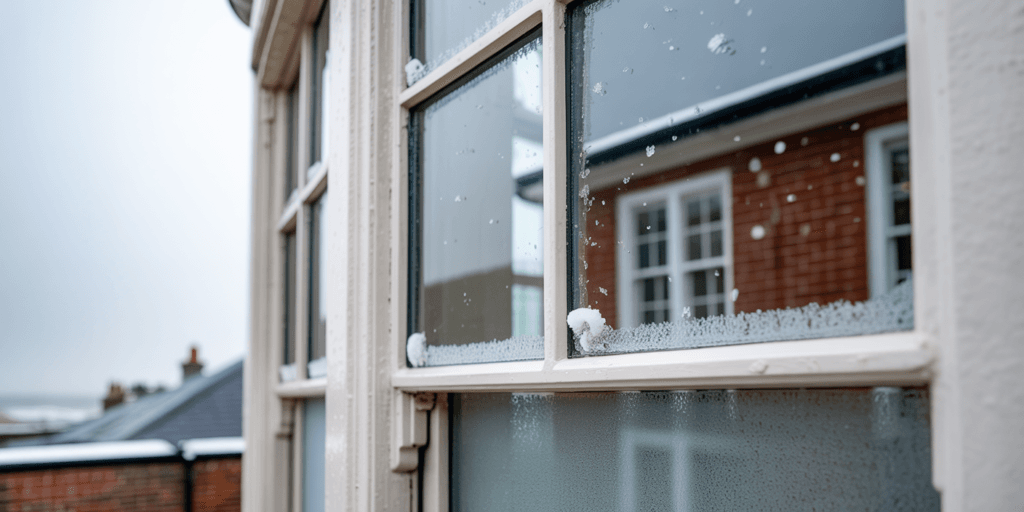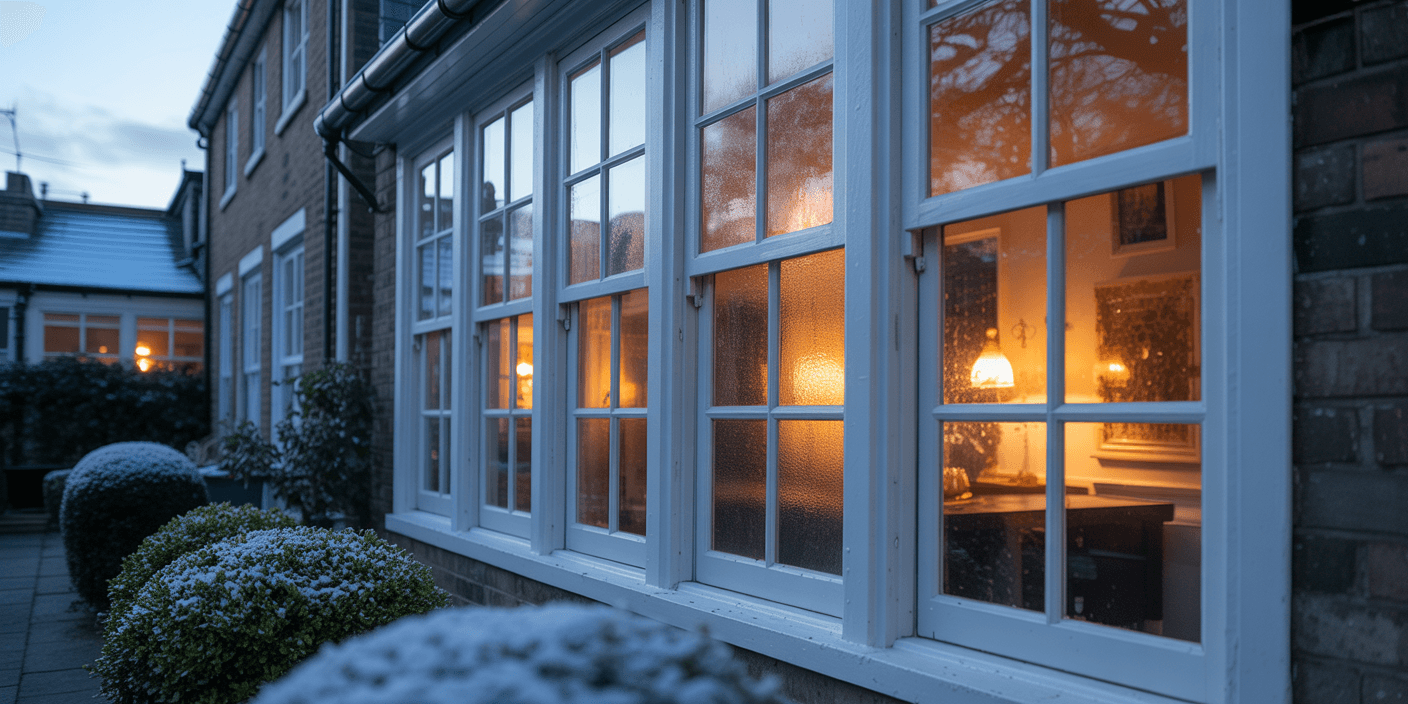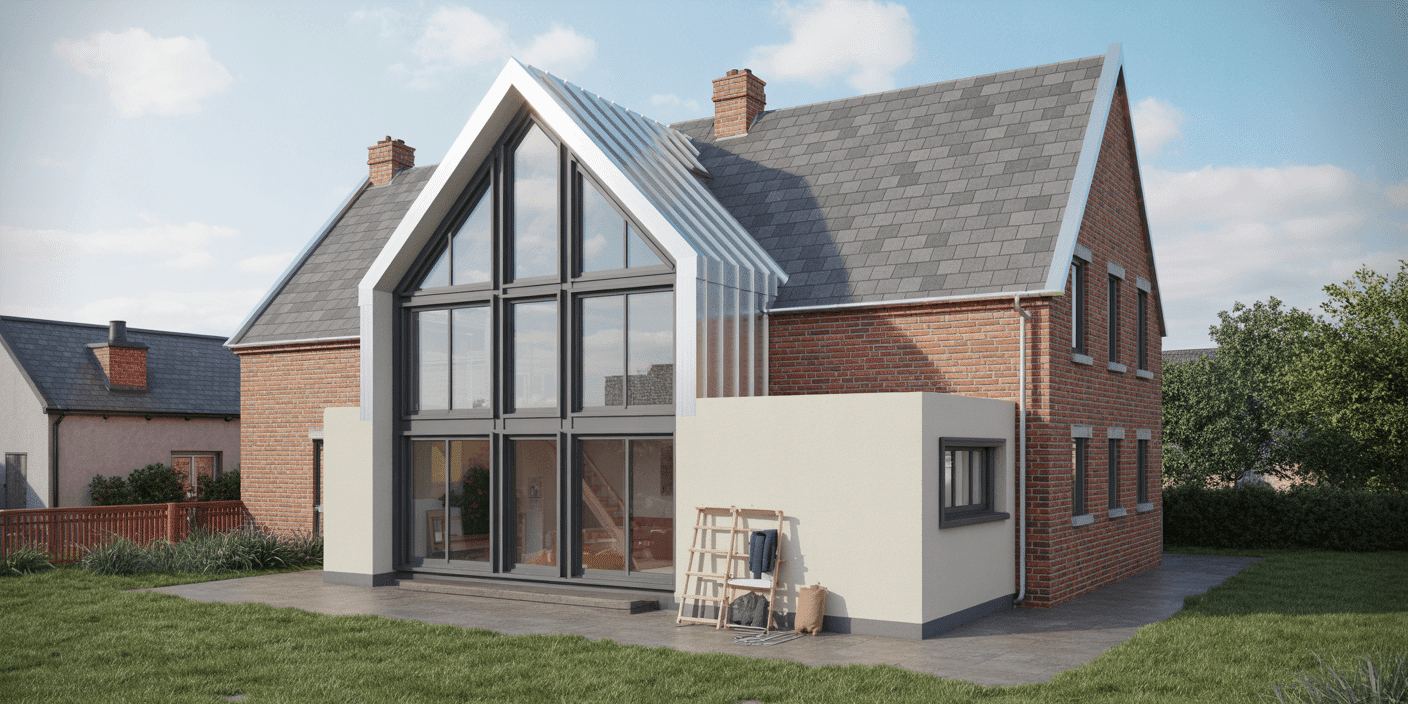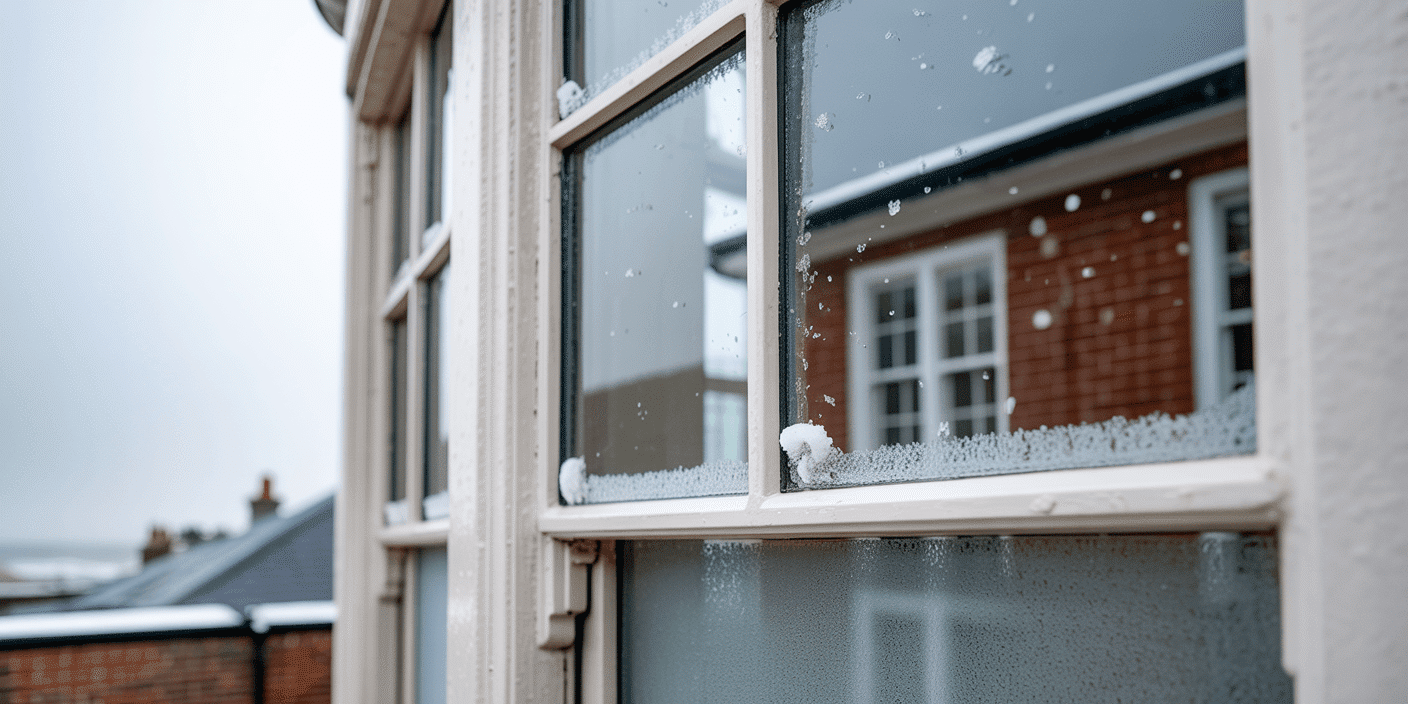Winter Is Approaching — Are Your Windows Up to Standard?
As the days shorten and temperatures drop, the ambient warmth within your home begins to slip away — often more rapidly than expected. You turn up the thermostat. You reach for another layer. Yet the cold persists, subtly but insistently.
In most cases, it isn’t the heating system that’s underperforming. It’s the windows.
In a typical British home, up to 30% of total heat loss occurs through glazing. Much of this is due to outdated or under-insulated window systems — single glazing, degraded seals, and thermally inefficient frames. The result is higher energy usage, rising fuel bills, and diminished indoor comfort.
What many homeowners overlook is that this performance gap is not abstract. It’s quantifiable. The rate at which heat escapes through a window is measured by a U-value — a critical metric in both building regulation and practical energy efficiency. The lower the U-value, the better the window resists heat loss.
High-performance glazing can dramatically improve the thermal stability of a home. When frames are properly sealed, materials are thermally broken, and modern glass technology is applied, the difference is immediate and measurable.
For over two decades, Sash Windows London has helped homeowners across the capital reconcile tradition with performance — maintaining architectural integrity while significantly improving energy efficiency.
In advance of winter, it is worth asking:
Are your windows helping you retain heat — or quietly letting it escape?
What Is a U‑Value — and Why Should You Care?
Ask ten homeowners about U‑values and you’ll get nine puzzled looks and one vague answer about “insulation.” Yet this single number quietly determines how comfortable, efficient and valuable your home really is.
In simple terms: a U‑value measures how well a material stops heat escaping. The lower the number, the better the performance. Think of it as a “leak score.” A window with a U‑value of 1.4 W/m²K lets far less warmth escape than one rated 2.8 — and the difference shows every time the heating comes on.
When you stand near an old sash window and feel a cold downdraft, that’s not bad luck; it’s a physics lesson. Glass, timber and seal all conduct heat differently. The more poorly they’re assembled, the faster the warmth you’ve paid for slips away.
Government building regulations recognise this, which is why Part L now insists on ever‑lower U‑values for new and replacement windows. It’s not bureaucracy; it’s protection against spiralling energy waste. The smaller the U‑value, the smaller your carbon footprint — and your gas bill.
But numbers alone don’t make a home inviting. Precision joinery does. High‑spec glazing does. The quiet satisfaction of a well‑sealed frame does. That’s where craftsmanship meets compliance — where a company like Sash Windows London turns a technical standard into lived comfort.
Understanding your U‑values isn’t about chasing jargon; it’s about taking control of how your home feels in February. Because the moment you grasp what that figure means, you stop accepting cold rooms as inevitable.
How Heat Escapes Through Your Windows (And What It’s Costing You)

You might not see it, but every winter night, your home is bleeding warmth. It’s not just a bit of draught around the frame — it’s litres of heat vanishing invisibly through every square inch of cold, underperforming glass.
Old or poorly specified windows act like thermal sieves. Glass conducts heat faster than brick or plasterboard, and single glazing does little to stop it. Even double glazing can underdeliver if it lacks modern insulating technologies — low-emissivity coatings, argon gas fills, or warm edge spacers.
And the cost? Significant. Studies show that up to 30% of a home’s heat loss escapes through windows. That’s not a figure — it’s your heating budget being spent outside. A poorly performing window with a U-value of 2.8 or higher can effectively double your energy loss compared to a modern system rated 1.4 or lower.
But it’s not just about numbers on a bill. It’s the cold spot you avoid in the living room. The chill that settles overnight in your child’s bedroom. The condensation that creeps in around the frame, leading to black mould and peeling paint.
Heat loss affects your comfort, your health, and your property’s long-term value.
This is where Sash Windows London steps in — not as mere installers, but as thermal strategists. They assess the anatomy of heat loss in period and contemporary homes alike, offering solutions that are invisible to the eye but profound to the touch.
Through carefully engineered timber sash replacements, slimline double glazing, and heritage-compliant upgrades, they turn your window from the weak point of your insulation into the stronghold of your warmth.
Every window tells a story. The question is: does yours say “cosy and efficient” or “leaking warmth by the hour”?
The Hidden Power of High-Performance Glazing
Modern glazing is no longer just about blocking the wind or dampening the noise. Done properly, it becomes an active part of your home’s climate control system — invisible to the eye, but powerful to the bone.
Yet too many homeowners still think of energy efficiency as something that comes after the design — a sacrifice made for warmth, a compromise wrapped in uPVC. That thinking belongs to another decade.
Today’s high-performance windows do something different. They disappear into the architecture — whether you’re restoring a Georgian townhouse or building a contemporary eco-home — while delivering U-values once reserved for passive houses.
Inside each unit, a network of silent technology does the heavy lifting:
- Low-emissivity (Low-E) coatings reflect heat back into the room
- Argon-filled chambers insulate better than air
- Warm-edge spacers reduce thermal bridging at the perimeter
- Triple glazing further suppresses heat loss and sound transfer
- Thermally broken frames stop the frame itself from becoming a conductor
What does that mean in human terms?
It means no cold spots by the window.
It means lower heating bills without touching the thermostat.
It means sash windows that look original but outperform expectations.
And this is where Sash Windows London quietly leads the industry. By pairing traditional craftsmanship with contemporary science, they ensure that even a 19th-century bay window can meet 21st-century standards — without spoiling the sightlines or charm.
No gimmicks. No over-engineering. Just glass that works harder, frames that insulate smarter, and homes that stay warmer — beautifully.
In a world where energy is expensive and comfort is priceless, the right glazing isn’t a luxury. It’s a strategy.
Don’t Get Caught Out by Part L — The Legal Implications of U-Values
You may love how your windows look. But if they don’t meet Part L of the UK Building Regulations, you could find yourself on the wrong side of compliance — and paying for it twice.
Part L governs energy efficiency in buildings. It’s not a suggestion — it’s the law. And right now, it requires that all new or replacement windows achieve a U-value of 1.4 W/m²K or better in England and Wales (lower still in Scotland).
For many older windows — including double-glazed units installed just a decade ago — that’s a number well out of reach.
Fail to comply, and you risk:
- Delays in planning approval
- Failed building control inspections
- Retroactive redesigns at your cost
- Reduced SAP ratings — and a knock to your property’s EPC
For developers, architects, and homeowners alike, this isn’t just bureaucracy. It’s the difference between a smooth project and a regulatory quagmire.
But compliance doesn’t have to be a compromise. The best companies treat Part L not as a constraint, but a minimum standard to exceed.
That’s exactly where Sash Windows London operates — in the space where craftsmanship meets compliance. They know the thresholds, the thermal models, the performance proofs. More importantly, they deliver window systems — timber, alu-clad, or heritage-grade sash — that pass first time, while still respecting the integrity of your home’s design.
You won’t hear about compliance issues from their clients — because the systems are engineered to anticipate them. That’s not luck. That’s the process.
And when the next set of regulations tightens (as they inevitably will), it won’t be the compliant ones scrambling. It’ll be the ones who cut corners.
So the question becomes simple: do your windows meet today’s standards — and tomorrow’s?
With the right partner, they will.
Heritage Homes Deserve Warmth Too — Without Losing Their Soul
For owners of period properties, winter brings a familiar dilemma: stay true to the original character, or finally do something about the freezing rooms and streaming condensation?
The sash windows are beautiful — perhaps original. But they rattle in the wind. They mist up on cold mornings. They let heat bleed out and cold settle in. And replacing them feels like a betrayal of the building itself.
It doesn’t have to be.
Modern window technology has evolved, not to erase the past, but to protect it — invisibly.
Today, it’s possible to install heritage-sensitive glazing systems that preserve every aesthetic detail while delivering modern-day thermal performance. You keep the look, the lines, the texture. What changes is the experience.
- Slimline double glazing fits into traditional sash profiles
- Low-E glass and inert gas fills boost insulation without changing appearance
- Putty-line glazing and horn detailing retain authenticity
- Specialist timber finishes match original joinery with uncanny accuracy
- Listed-building–friendly systems meet local conservation requirements
But this isn’t something you trust to a generic glazing firm. It’s a specialist art — and one Sash Windows London has mastered over years of quiet work on Grade II, conservation area, and heritage properties across the capital.
Their team liaises directly with planning officers, provides detailed drawings and specs, and supplies Part L–compliant sash replacements that don’t just meet legal standards — they win aesthetic praise from even the strictest heritage committees.
The result? A home that’s true to its origins, but liveable by today’s expectations. Rooms that stay warm, windows that still open beautifully, and bills that finally make sense.
You don’t have to choose between character and comfort.
With the right design, you get both.
How U-Value Upgrades Deliver Value That Lasts for Decades
Most home improvements fade with time. A fresh coat of paint. A new kitchen tap. Even a fancy thermostat eventually becomes just part of the furniture. But high-performance windows? They work quietly, every day, for decades, protecting your warmth, your wallet, and your investment.
When you improve your windows’ U-values, you’re not just ticking a box on an energy report. You’re installing a long-term thermal defence system — one that actively reduces your heating demand, stabilises your indoor environment, and delivers measurable ROI year after year.
Here’s what that looks like:
- A 30%+ reduction in annual heating bills, depending on your previous window spec
- Improved EPC rating, boosting resale value and mortgage attractiveness
- Enhanced acoustic insulation, particularly important in urban homes
- Lower maintenance costs, with durable finishes and fewer condensation issues
- Future-proofing against tighter energy regulations and escalating fuel prices
But there’s a less obvious form of return too — the quality of life upgrade.
You feel it in the bedroom that no longer runs cold.
You hear it in the silence that replaces street noise.
You see it in the mould that never comes back.
You realise it every time winter rolls in — and you’re not worried.
This is the kind of investment you make once and benefit from forever.
That’s why Sash Windows London treats every install not as a transaction, but as a legacy intervention. Their systems aren’t built to last five years. They’re designed to perform for generations, using robust materials, precision craftsmanship, and glazing technology that has already outpaced current regulations.
You’re not just saving money. You’re upgrading your home’s DNA.
And in a property market increasingly focused on efficiency, comfort, and compliance, that’s a smart move — now and later.
Ready to Act? Start with the Glass That Pays You Back
There’s no need for urgency when the evidence speaks for itself.
You’ve felt the draughts. You’ve seen the numbers. You understand what’s at stake — not just for this winter, but for every one that follows.
So the question becomes simple: how long will you keep paying for heat you never get to enjoy?
Windows may seem static, but they’re anything but passive. They’re the line between the climate inside and out — and whether they defend your home or betray it comes down to a number: the U-value.
At Sash Windows London, they don’t just meet standards. They anticipate them. With heritage-approved designs, slimline double and triple glazing, and timber systems tested to outperform expectations, they turn cold problems into warm solutions — beautifully.
And if you’re not sure where to begin, they’ll meet you at the start. No push. Just clarity.
Here’s what you can do next:
Download Your Winter Window Spec Pack
Includes:
✓ U-value reference chart
✓ Frame and glazing options
✓ Regulatory checklist (Part L, Q, K)
Request a Thermal Imaging Audit
See the heat you’re losing — and how much you could retain
Book a Consultation with Sash Windows London
Ask the questions. Get the facts. No jargon. No pressure.
A well-built window doesn’t just change the way a room feels.
It changes the way you feel about your home.
This winter, let it work for you.







